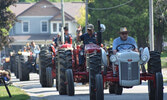Annual Lucknow tractor parade brings nearly 125 machines to the village
BY SCOTT STEPHENSON
On Saturday morning, Lucknow’s annual Antique Tractor Parade plowed its way through town once again, filling the air with the rumbling music of history’s greatest farm machine in action. The 2025 edition of the event showcased roughly 120 vintage tractors of all makes, models, shapes and sizes. While the blazing August sun drove parade spectators into the shady spots of the sidewalks, none of the parade’s participants seemed to be particularly bothered by the heat of the morning. Accompanying the spectacle was sprightly music from the Port Albert Pipe and Drum Band, which added the energy of a classic summer festival to the historic occasion.
The parade route wove through the heart of town, passing over bridges and trucking past local landmarks - including the United Church, Lucknow Bowl and Game Centre, the newly-renamed Bonnie Manor, down Campbell Street, past the old Cobblestone Pub, finally ending, as tradition dictates, outside of Mary’s Restaurant.
The roots of this agricultural evolution are wound through many pivotal moments in the story of North American prosperity. In 1837, the United States spiralled into a decade-long economic depression, triggered in part by shifts in domestic economic policies, such as the dismantling of the Second Bank of the United States and Andrew Jackson’s 1836 requirement that public lands be paid for in gold or silver instead of on credit. This destabilized the credit market and drained the U.S. economy, which, in turn, contributed to a jump in unemployment and widespread bank failures. Businesses closed, families went hungry, and western expansion slowed to a crawl.
In the same year, an Illinois blacksmith named John Deere debuted an innovative steel plow capable of cutting through the challenging prairie soil of the American Midwest. As more settlers headed westward, the plow made farming the frontier not only possible, but profitable. This and other industrial inventions of the time, along with the building of a national railroad system, allowed new lands to be farmed and, within a few decades, the United States had become a world leader in agriculture.
The parade’s lineup read like a roll call of significant historical farm machinery: a McCormick Standard, a pair of shiny Cockshutt 20s, a Massey-Harris 444, a White 1470, the Oliver Standard 88, a Farmall 230 - the list goes on. Equally impressive as the tractors themselves is the labour of love it takes to keep them up and running. Maintaining these machines is no small feat - parts can be scarce and expertise can be even scarcer. That they run at all is a testament to both the dedication of their owners and the resilience of 20th century engineering.
Peppered throughout the parade was the distinct Persian Orange of Allis-Chalmers tractors - a colour that was chosen in 1929 to evoke the imagery of California poppies in a field. There was also more than a little Prairie Gold on display - the official tractor colour of Minneapolis-Moline, a Minnesota-based manufacturer that was so inspired by the frigid farming conditions that they invented the Comfortractor, the first farm vehicle to feature an enclosed, heated cab.
Every Case 830 that rolled off the line came equipped with either an eight-speed transmission or a Case-o-matic drive - an innovative hybrid torque converter/direct-drive clutch designed to offer improved fuel efficiency or smoother transition between field and road speeds. While some farmers of the 1950s embraced the new technology, others felt it was less responsive than traditional gear-driven systems.
There was even a true cult-classic in the mix: a Silver King. These glorious rarities were originally known in the 1930s as “Plymouths,” since they hail from Plymouth, Ohio. Unlike many farm tractors of the era, even early models of this powerful performance tractor reached speeds of up to 25 miles per hour. Henry Ford himself was impressed with the Silver King’s engineering, and they quickly became popular not only with farmers, but also highway crews. The Silver King even made it big in Hollywood, where they were used to move sets around studio lots of the 1940s.
Saturday’s long line of antique tractors was more than just a parade - it was a mobile monument to innovation and a living museum of agricultural history on the move. The tractor transformed farming forever; before its arrival, field work depended on teams of horses or oxen. Tractors revolutionized agriculture, enabling farmers to cultivate larger areas with less labour and greater efficiency. All of the machines on display in Lucknow are artifacts of that transformation; rolling examples of human ingenuity, mechanical craftsmanship, and the importance of preserving farming’s legacy, one tractor at a time.


